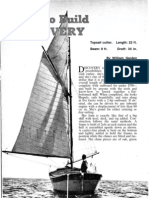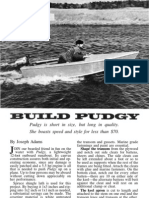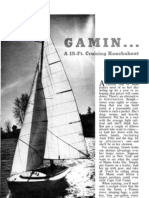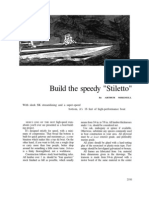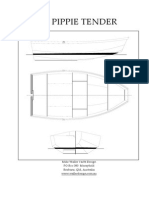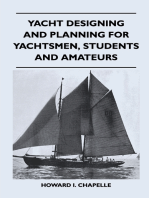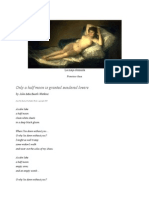Building Meerkat, A Very Small Catboat
Building Meerkat, A Very Small Catboat
Uploaded by
John M. WatkinsCopyright:
Available Formats
Building Meerkat, A Very Small Catboat
Building Meerkat, A Very Small Catboat
Uploaded by
John M. WatkinsCopyright
Available Formats
Share this document
Did you find this document useful?
Is this content inappropriate?
Copyright:
Available Formats
Building Meerkat, A Very Small Catboat
Building Meerkat, A Very Small Catboat
Uploaded by
John M. WatkinsCopyright:
Available Formats
Building Meerkat,
a very small catboat
by John MacBeath Watkins Rather than wanting a bigger boat, I find I keep wanting a smaller one. I had a 30-foot keelboat, a Yankee One-Design, which was great. But wouldn't it cost less and make life simpler if I had a smaller one? I restored a 50-year-old Snipe, but it was too heavy for me, with my bad back, to pull up on the dinghy dock by myself, and it would only hold two people, so I had to have exactly two people every time I went sailing. I designed and built a sharpie, Black Swan, using the Snipe rig. She was light enough for me to pull on the dinghy dock and roomy enough for three people, and was very pleased with this boat as long as I kept it on a dinghy dock. Then I moved to Vashon Island, where it cost more than $100 to get on the ferry while towing a boat on a trailer. And the rather complex Snipe racing rig took a while to set up on launching.
Clearly, I needed a boat that I could fit in the back of my 1997 Nissan truck and under its canopy, pull out and plop in the water, and still take a friend out on. I'd been teaching myself to use some yacht design software, Delftship, when I ran across an ad on Craig's List for a $200 El Toro. The 8-foot bullship seemed to fit the bill, except that if I took a friend, they'd need to be small, and the daggerboard and rudder would snub when coming into a beach, and if I needed to tow the boat behind another vessel, water would shoot up the daggerboard case and the El Toro would stubbornly refuse to exceed its hull speed of about four knots. I bought it anyway, for the rig, then designed a boat of about the same beam and a little more length that could readily accommodate two adults, row well and tow well and exceed hull speed rather than sail under in the comical fashion I'd seen back when I raced El Toros in strong winds. The El Toro rig is a cat rig, so I designed a catboat. But most catboats are based on the Cape Cod catboats perfected by the Crosby family. If the boat were to have the displacement to carry two people and be narrow enough to fit in a truck bed with a canopy, I needed to keep the beam narrow. There is an older type of catboat, the New York catboat, in lager sizes given a sloop rig. One of these catboats, the 16-foot Una, wowed the British when she showed up at the Isle of Wight in 1852. The type, in addition to inspiring the sandbaggers that raced in the 1860s to about 1880, inspired Cape Cod catboats, also led to the British centerboard dinghies, which were revolutionized by Uffa Fox and became in their turn the basis for most racing dinghies today. An example of the type is Comet, designed and built by Archibald Cary Smith in 1862 and raced both as a catboat and a sloop. She was pretty much designed on the building molds, but John Hyslop took her lines off about 30 years later. 2
But the boat would have to live out of the water and still not leak, and I'd need to design it for construction by a method a ten-thumbed wood butcher like myself could do. I chose plywood, and stitch and glue construction, which should allow me to build the boat in the narrow window of at most two months in which an outdoor boat builder can count on not too much rain the the Pacific Northwest. This meant that I would have to find some way to simulate the slack bilges of the New York catboat in plywood. Here's my solution:
At 9 feet long, she's about half the length of Comet, but has nearly the same freeboard, which I think is about the right amount for a boat this size. Because she is a catboat, I've given her a barn-door rudder, but put it behind a short, deep skeg so that she's not too likely to be caught in irons. The faceted midsection, with a narrow, flat bottom, flaring bilges and straight sides, is very much like that of the first boat I ever owned, a Thai sampoa. This midsection always struck me as a nice compromise between stability, load carrying, and form resistance, and yielded a boat that handled well. It was a boat like this:
I needed scale drawings of the templates for the plywood panels, but the free version of Delftship does not allow you to print these out. A Canadian on-line friend, Bruce Taylor, had helped write the code for Deftship, and been given the professional version in return. He printed them out and sent them to me. Then, I changed the design. Too embarrassed to ask for the favor a second time, I discovered that I could download Freeship, the program Delftship was derived from, replicate the design in it, and print out the panels in 1/12 scale. Vashon Printing & Design scanned them and printed full-sized panels on their plotter. I still wasn't out of the woods. I needed bulkheads to put the panels around, to help give the hull shape. I lofted those from the offsets Delftship provided. Then I glued the sheets to doorskin panels, thinking I would be able to use a rounter to make a nice, clean cut on my building panels. They proved too thin for the roller on the router bit to read properly, so I laid the panels over my 4 mm okume 4
marine plywood (scarfed to the right length,) roughed them out with a jigsaw, and finished them with a hand plane. They looked like this:
And stitched together like this:
It only took about a week to produce the shape of the hull:
The hull was at this point fairly flexible, and I used a spreader a 1x1 with some screws in it at the right places to hold the right beam, and added the right weights and support to straighten out the hull before I added the sheer clamps (1x1 rails inside the top of the sides) and the decks enclosing the air chambers at bow and stern. At that point, the boat was fairly stiff. Then I had to design and build the centerboard case and centerboard. A boat designed to be launched at a beach needs a kick-up centerboard so that you can sail into the beach without having it stop the boat the way a daggerboard does. It has to be fitted to the shape of the bottom, and it needs something with a bit of meat to it to key into. I put a 6' X 6 X piece of western red ceder in the bottom to key the centerboard case into and provide some strength. It took longer to do this, cut the slot for the centerboard, build the centerboard case, and build the centerboard than it did to build the hull.
I used 4 mm Okume for the sides of the centerboard case and 1x3 pine for the bed logs for the case, with some inch western red cedar at the top and on the sides to take the loads of the centerboard pin. The case is designed to take up as little room as possible in the boat while providing a nice, long leading edge to the centerboard, which is key shaped. The fairly high pin allows me to have less of the centerboard case and its lifting handle ahead of the pin while still having enough board in the case 6
provide plenty of structure. The board is inch plywood, plenty strong for the minimal forces that will be placed on it. I made the front edge rounded, the back of the board tapered, and didn't worry too much about a perfect foil shape. I figure when I'm sailing, it's at about the angle you see here, held down with a line through that hole at the top, which I lead to a cleat on the case. Because Meerkat is much deeper forward than the El Toro my mast came out of, I built the mast step so that the mast is suspended about 8 above the bottom of the boat. The fillets, by the way, are milled fiberglass mixed with epoxy, which have proven strong enough for my friend Bruce Smith to go pounding around at 30 knots in his little powerboats. I didn't like the idea of sanding this mixture, so instead I used fairing compound to cover them and faired that. I couldn't get her out of the back yard by myself, so I enlisted the aid of Joby, the local postmistress, and took her on the first sail. Meerkat (the name means sea cat, though why a creature that is the South African equivalent to a prairie dog is called that I don't know) stepped along nicely, though it quickly became evident that the 45-year old mast was too flexible and the 45-year-old sail was a horribly blown-out bag. But no time to worry about that, I'd finished her just in time for the Norm Blanchard WOOD 7
regatta. A couple of instrument makers from Dusty Strings helped me carry the boat down to the dock and launch her. The next morning, after a brief conference with a naval architect about what revisions we should make to the Coleen Wagner, the Egret replica the Center for Wooden Boats uses for public sail, I ducked out in time to rig the boat and go racing against a Beetle Cat (which rates faster) and a Pelican (which rates slower) and in a class where my fleet times were compared to El Toros. The sail still looked like a bag, but Meerkat proved quick in spite of it, gaining a provisional rating a bit faster than the better boats in the El Toro class. I won my class, but unfortunately the glue joint between the two halves of the ancient mast failed in the last race, and my mast split vertically. Well, I'm now ready with a new mast, my old sail, and a Meerkart for Meerkat so that I don't have to rely upon the kindness of strangers for help loading or launching the boat. Anyone want to go sailing?
You might also like
- Lofting A Boat A Step-By-Step Manual PDFDocument221 pagesLofting A Boat A Step-By-Step Manual PDFmauricio matus83% (6)
- Instant Boatbuilding with Dynamite Payson: 15 Instant Boats for Power, Sail, Oar, and PaddleFrom EverandInstant Boatbuilding with Dynamite Payson: 15 Instant Boats for Power, Sail, Oar, and PaddleRating: 4.5 out of 5 stars4.5/5 (3)
- Discovery Topsail CutterDocument5 pagesDiscovery Topsail CutterJim89% (19)
- Bluenose Practicum Standard PDFDocument138 pagesBluenose Practicum Standard PDFindumarnicaragua100% (2)
- Tinkerbelle 2Document6 pagesTinkerbelle 2Jim100% (14)
- 22ft BoatDocument14 pages22ft BoatDaniel Bagiński75% (4)
- Plywood Boat PlansDocument3 pagesPlywood Boat Plansjacquesmayol100% (4)
- A Boat Builder's Guide to Hull Design and Construction - A Collection of Historical Articles on the Form and Function of Various Hull TypesFrom EverandA Boat Builder's Guide to Hull Design and Construction - A Collection of Historical Articles on the Form and Function of Various Hull TypesNo ratings yet
- Bonnie Two SailboatDocument18 pagesBonnie Two SailboatJim96% (27)
- Hans Brinker Sailboat PlansDocument7 pagesHans Brinker Sailboat PlansJim95% (22)
- The 10.5ft Pointy Skiff Full PlansDocument7 pagesThe 10.5ft Pointy Skiff Full PlansMaria Vasile100% (2)
- Star Lite SailboatDocument13 pagesStar Lite SailboatJim100% (10)
- 212 Woodenboat-Issue PDFDocument148 pages212 Woodenboat-Issue PDFpamela4122No ratings yet
- The 23.5ft Light Schooner Full PlansDocument7 pagesThe 23.5ft Light Schooner Full PlansAlphamatrix01100% (1)
- Sabot 8 FT Pram DinghyDocument6 pagesSabot 8 FT Pram DinghyFrenchwolf420100% (2)
- Saucy Skimmer AKA Saucy Shingle Hydroplane Boat PlansDocument8 pagesSaucy Skimmer AKA Saucy Shingle Hydroplane Boat PlansJim100% (6)
- Hydro Dynamic HydroplaneDocument10 pagesHydro Dynamic HydroplaneJim100% (7)
- Drills For Teaching SailingDocument14 pagesDrills For Teaching SailingJohn M. Watkins67% (3)
- The Torturer's ApprenticeDocument13 pagesThe Torturer's ApprenticeJohn M. WatkinsNo ratings yet
- Building The Sharpie Black SwanDocument6 pagesBuilding The Sharpie Black SwanJohn M. Watkins100% (6)
- Joy of SharpiesDocument5 pagesJoy of SharpiesJohn M. Watkins50% (2)
- Dudley Dix-Dudley Dix Design Cape Henry 21 Sailboat Boat Yacht Plan Plans-WoodenBoat Magazine (2010)Document6 pagesDudley Dix-Dudley Dix Design Cape Henry 21 Sailboat Boat Yacht Plan Plans-WoodenBoat Magazine (2010)cochelo777100% (2)
- Flying DutchmanDocument12 pagesFlying DutchmanJim100% (15)
- ButterflyDocument4 pagesButterflyJim100% (3)
- Build StornDocument7 pagesBuild Storndavidantoni100% (2)
- Mason 33 Practical ReviewDocument5 pagesMason 33 Practical ReviewManuelPérez-Sola100% (1)
- Simple Boat-Building - Rowing Flattie, V-Bottom Sailing Dinghy, Moulded Pram, Hull for OutboardFrom EverandSimple Boat-Building - Rowing Flattie, V-Bottom Sailing Dinghy, Moulded Pram, Hull for OutboardNo ratings yet
- Unsinkable UniboatDocument6 pagesUnsinkable UniboatJim100% (4)
- Flying CloudDocument14 pagesFlying CloudJim96% (27)
- Teacup SailboatDocument9 pagesTeacup SailboatJim100% (11)
- Pudgy A 12 Foot Canvas Runabout Boat PlansDocument5 pagesPudgy A 12 Foot Canvas Runabout Boat PlansJim100% (6)
- Gamin Sailboat PlansDocument6 pagesGamin Sailboat PlansJim100% (11)
- River Boat Built For White WaterDocument5 pagesRiver Boat Built For White WaterJim100% (2)
- Stiletto BoatDocument7 pagesStiletto BoatJim100% (5)
- Sharpie 600 PDFDocument9 pagesSharpie 600 PDFLuis Martinez100% (1)
- Sports Boat, Build A SleekDocument9 pagesSports Boat, Build A SleekJim100% (3)
- South Haven Dory PlansDocument9 pagesSouth Haven Dory PlansAlphamatrix01No ratings yet
- Nine Motor Boats and How To Build ThemDocument136 pagesNine Motor Boats and How To Build ThemMaxi Sie100% (1)
- ILUR - Plan 11 Rev 2 General Arrangement Plan Scale 1/15 19 June 2013 François Vivier Architecte NavalDocument1 pageILUR - Plan 11 Rev 2 General Arrangement Plan Scale 1/15 19 June 2013 François Vivier Architecte NavalGEORGE KARYDISNo ratings yet
- Guenther GarveyDocument4 pagesGuenther GarveyJim100% (1)
- Two DoriesDocument10 pagesTwo DoriesAlphamatrix01No ratings yet
- Station Wagon SkiffDocument8 pagesStation Wagon SkiffJim100% (3)
- Caravela 1.7: Free Plans: How To Build TheDocument31 pagesCaravela 1.7: Free Plans: How To Build TheKeith WilliamsNo ratings yet
- 100 Boat Designs ReviewedDocument274 pages100 Boat Designs ReviewedDoug8183100% (2)
- Venice Boat Plans Info and Materials ListDocument7 pagesVenice Boat Plans Info and Materials ListSkirmantas LatvaitisNo ratings yet
- Tore Holm - Bronze Fastenings - Butterfly Skylight: The Magazine For Wooden Boat Owners, Builders, and DesignersDocument140 pagesTore Holm - Bronze Fastenings - Butterfly Skylight: The Magazine For Wooden Boat Owners, Builders, and DesignersPablo BesserNo ratings yet
- The Pippie Tender: Mike Waller Yacht Design PO Box 383 Morayfield Brisbane, QLD, AustraliaDocument0 pagesThe Pippie Tender: Mike Waller Yacht Design PO Box 383 Morayfield Brisbane, QLD, AustraliaacastromNo ratings yet
- Model Racing Yachts - Being No. 6 of the New Model Maker Series of Practical Handbooks Covering Every Phase of Model Building and Design - With 90 Illustrations Including 12 Practical Working DesignsFrom EverandModel Racing Yachts - Being No. 6 of the New Model Maker Series of Practical Handbooks Covering Every Phase of Model Building and Design - With 90 Illustrations Including 12 Practical Working DesignsRating: 4 out of 5 stars4/5 (1)
- Practical Boat Building for Amateurs: Full Instructions for Designing and Building Punts, Skiffs, Canoes, Sailing Boats, Etc.From EverandPractical Boat Building for Amateurs: Full Instructions for Designing and Building Punts, Skiffs, Canoes, Sailing Boats, Etc.No ratings yet
- Small-Boat Sailing - An Explanation of the Management of Small Yachts, Half-Decked and Open Sailing-Boats of Various Rigs, Sailing on Sea and on River; Cruising, Etc.From EverandSmall-Boat Sailing - An Explanation of the Management of Small Yachts, Half-Decked and Open Sailing-Boats of Various Rigs, Sailing on Sea and on River; Cruising, Etc.Rating: 4 out of 5 stars4/5 (4)
- Yacht Designing and Planning for Yachtsmen, Students and AmateursFrom EverandYacht Designing and Planning for Yachtsmen, Students and AmateursRating: 5 out of 5 stars5/5 (1)
- How to Build Wooden Boats: With 16 Small-Boat DesignsFrom EverandHow to Build Wooden Boats: With 16 Small-Boat DesignsRating: 3.5 out of 5 stars3.5/5 (9)
- A Practical Course in Wooden Boat and Ship BuildingFrom EverandA Practical Course in Wooden Boat and Ship BuildingRating: 4 out of 5 stars4/5 (1)
- The Blue Man Speaks of Octopus InkDocument4 pagesThe Blue Man Speaks of Octopus InkJohn M. WatkinsNo ratings yet
- What Huck Finn Means To MeDocument4 pagesWhat Huck Finn Means To MeJohn M. WatkinsNo ratings yet
- God of DoubtDocument8 pagesGod of DoubtJohn M. WatkinsNo ratings yet
- The Role-Playing GameDocument2 pagesThe Role-Playing GameJohn M. Watkins100% (1)
- Sex, Death and The Selfish MemeDocument5 pagesSex, Death and The Selfish MemeJohn M. WatkinsNo ratings yet
- She Lept As Light As LaughterDocument1 pageShe Lept As Light As LaughterJohn M. WatkinsNo ratings yet
- To Read Is To Become A Stolen ChildDocument4 pagesTo Read Is To Become A Stolen ChildJohn M. WatkinsNo ratings yet
- Why I Am Not An AtheistDocument8 pagesWhy I Am Not An AtheistJohn M. WatkinsNo ratings yet
- Flight of The EuphemismDocument4 pagesFlight of The EuphemismJohn M. WatkinsNo ratings yet
- Songbirds of The Primate World and The Poets Who Fail To SingDocument6 pagesSongbirds of The Primate World and The Poets Who Fail To SingJohn M. WatkinsNo ratings yet
- The Book of Forbidden WordsDocument258 pagesThe Book of Forbidden WordsJohn M. Watkins100% (8)
- Sex and The Single Neanderthal: Interbreeding and ExtinctionDocument4 pagesSex and The Single Neanderthal: Interbreeding and ExtinctionJohn M. WatkinsNo ratings yet
- The "Neanderthal Enigma" and The Structure of ThoughtDocument5 pagesThe "Neanderthal Enigma" and The Structure of ThoughtJohn M. WatkinsNo ratings yet
- Canal Life in ThailandDocument9 pagesCanal Life in ThailandJohn M. WatkinsNo ratings yet
- For Him That Stealeth A BookDocument1 pageFor Him That Stealeth A BookJohn M. WatkinsNo ratings yet
- The Impossibility TheoremDocument1 pageThe Impossibility TheoremJohn M. WatkinsNo ratings yet
- Only A Half Moon Is Granted Sundered LoversDocument1 pageOnly A Half Moon Is Granted Sundered LoversJohn M. WatkinsNo ratings yet
- A Confession To The Murder of The Queen of EnglandDocument10 pagesA Confession To The Murder of The Queen of EnglandJohn M. WatkinsNo ratings yet
- The Pirate With A Hook For A HeartDocument1 pageThe Pirate With A Hook For A HeartJohn M. WatkinsNo ratings yet
- Prayers of The UnbelieversDocument350 pagesPrayers of The UnbelieversJohn M. Watkins100% (1)


